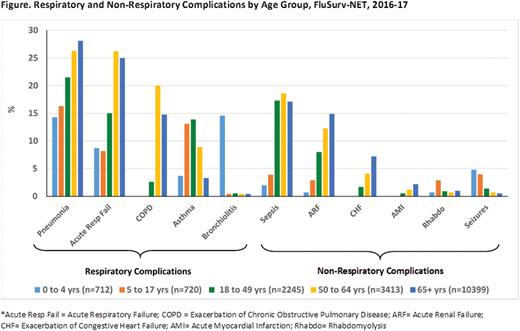-
PDF
- Split View
-
Views
-
Cite
Cite
Shikha Garg, Charisse Nitura Cummings, Alissa O’Halloran, Pam Daily Kirley, Rachel Herlihy, Kimberly Yousey-Hindes, Maya Monroe, Seth Eckel, Melissa McMahon, Kathy Angeles, Alison Muse, Nancy M Bennett, Laurie Billing, Ann Thomas, H Keipp Talbot, Andrea George, Evan J Anderson, Carrie Reed, 720. Respiratory and Nonrespiratory Complications Among Patients Hospitalized with Influenza, FluSurv-NET, 2016–2017, Open Forum Infectious Diseases, Volume 5, Issue suppl_1, November 2018, Pages S258–S259, https://doi.org/10.1093/ofid/ofy210.727
Close - Share Icon Share
Abstract
Influenza is most commonly associated with respiratory complications; however, nonrespiratory complications occur frequently among patients hospitalized with influenza. We used data from the Influenza Hospitalization Surveillance Network (FluSurv-NET) to describe complications recorded on discharge summaries of patients hospitalized with influenza.
We included children (0–17 years) and adults (≥18 years), who resided within a FluSurv-NET catchment area and were hospitalized with laboratory-confirmed influenza during 2016–2017. We abstracted data on underlying conditions and discharge diagnoses from medical charts. We calculated the frequency of respiratory and nonrespiratory complications in all age groups and used univariate and multivariable logistic regression to examine factors associated with select complications among adults.
Among 17,489 patients, the most common respiratory complications were pneumonia (26%) and acute respiratory failure (23%) and the most common nonrespiratory complications were sepsis (16%) and acute renal failure (ARF) (12%). Complications varied by age group (figure). Pneumonia was the most common respiratory complication in all age groups except 0–4 years; among children aged 0–4 years bronchiolitis was most common (104/712; 15%). Among 97 children aged 0–4 years with bronchiolitis who underwent testing for respiratory syncytial virus (RSV), 37% had RSV. The most common nonrespiratory complication was seizures in children aged 0–17 years (17% had a history of prior seizures) and sepsis in adults. Among adults (n = 16,057), factors most strongly associated with ARF included chronic renal disease (adjusted odds ratio (AOR) 2.5; 95% confidence interval (95% CI) 2.2–2.8), male sex (AOR 1.5 95% CI 1.4–1.7) and age ≥65 years (AOR 1.4 95% CI 1.2–1.7); the factor most strongly associated with sepsis was chronic neuromuscular disease (AOR 1.5 95% CI 1.3–1.8).
Influenza hospitalizations are associated with a broad spectrum of complications including pneumonia, respiratory failure, sepsis, ARF and seizures. During the influenza season, astute clinicians should keep influenza in the differential diagnosis for patients with a wide range of presentations.

:Disclosures. H. K. Talbot, sanofi pasteur: Investigator, Research grant. Gilead: Investigator, Research grant. MedImmune: Investigator, Research grant. Vaxinnate: Safety Board, none. Seqirus: Safety Board, none. E. J. Anderson, NovaVax: Grant Investigator, Research grant. Pfizer: Grant Investigator, Research grant. AbbVie: Consultant, Consulting fee. MedImmune: Investigator, Research support. PaxVax: Investigator, Research support. Micron: Investigator, Research support.
Session: 69. Respiratory Infections: Viral
Thursday, October 4, 2018: 12:30 PM
- neuromuscular diseases
- sepsis
- influenza
- consultation
- seizures
- kidney failure, chronic
- bronchiolitis
- renal failure, acute
- respiratory failure, acute
- adult
- catchment area (health)
- child
- consultants
- differential diagnosis
- disclosure
- inpatients
- pneumonia
- respiratory insufficiency
- respiratory syncytial viruses
- safety
- respiratory complication
- surveillance, medical
- discharge summary





Comments